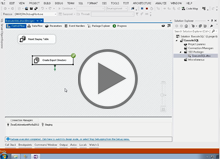Course description
Control Flows are the backbone of an Integration Services package. They contain the procedural logic that dictates the flow of execution through a package, such as grapping files from a remote server, cleaning out tables in a staging server, validating the files, kicking off the data flows to get the data where it needs to go, and cleaning up afterwards. Each Integration Services Package contains a single logical control flow. That can be as simple a single task or as complex as you need it to be. The Control Flow manages everything that happens in an Integration Services package. In this course you’ll learn about the various elements in a control flow, including tasks, containers, and precedents constraints. Then you’ll learn how to add tasks and configure them using both common elements as well as the unique features of each task. Next the course explores some of the tasks that you likely to use most often with some demos of their capabilities. We’ll wrap things up with a look at precedents constraints with both determine the order at which tasks execute as well as how they define overall work flow of your Integration Services package.
Prerequisites
This course assumes that you have a basic familiarity with the concept of relational databases and a basic understanding of what SQL Server is and the high-level tools in it, as well as how to create and manage objects using Management Studio. You should also have a basic understanding of how SQL Server implements security, including its authentication and authorization schemes, and how to assign permissions on securable objects to principals. You should know the fundamentals of Transact-SQL to write queries to retrieve data and join data from multiple tables, and how to execute scripts using the query editor in Management Studio. You must also know how to connect to an instance of SQL Server 2012 using the various connection dialog boxes in Management Studio and development tools.
It will be very helpful, but not absolutely necessary, to have experience with .NET development using Visual Studio 2012 or later for the portions of the course that deal with SQL Server Data Tools (which is a lot of it). At the very least, we’ll assume that you are well familiar with the Visual Studio user interface.
This course assumes no prior knowledge of SQL Server Integration Services.
Learning Paths
This course is part of the following LearnNowOnline SuccessPaths™:
SQL Server Integration Services
Meet the expert
Don Kiely is a featured instructor on many of our SQL Server and Visual Studio courses. He is a nationally recognized author, instructor, and consultant specializing in Microsoft technologies. Don has many years of teaching experience, is the author or co-author of several programming books, and has spoken at many industry conferences and user groups. In addition, Don is a consultant for a variety of companies that develop distributed applications for public and private organizations.
Course outline
Control Flows and Tasks
Overview of Control Flow (25:23)
- Introduction (00:44)
- Elements in a Control Flow (01:06)
- Tasks (01:34)
- Containers (01:35)
- Precedence Constraints (03:12)
- Configuring Tasks (01:21)
- Task Editor Dialog Box (00:34)
- Task Editor Process Page (00:38)
- Task Editor Expressions Page (01:01)
- Control Flow Tasks (01:06)
- Workflow Tasks (03:33)
- Data Processing Tasks (01:34)
- Scripting Tasks (01:39)
- SQL Server Tasks (01:37)
- Analysis Services Tasks (00:44)
- Maintenance Tasks (02:23)
- Summary (00:55)
The Execute SQL Task (29:05)
- Introduction (00:58)
- The Execute SQL Task (03:42)
- Demo: Execute SQL Task (00:33)
- Demo: Create Table (00:43)
- Demo: Execute Table (02:48)
- Demo: SQL Task Editor (01:04)
- Demo: Configure Connection (02:09)
- Demo: Select SQL Query (05:14)
- Demo: Populate Table (04:13)
- Demo: Execute Package (03:29)
- Demo: Execute again (03:39)
- Summary (00:26)
File System Task (10:45)
- Introduction (00:45)
- File System Task (02:05)
- Demo: Adding File System Task (01:48)
- Demo: Configure Task (02:53)
- Demo: Execute Task (02:26)
- Demo: Output Warnings (00:24)
- Summary (00:21)
FTP Task (13:22)
- Introduction (00:52)
- Demo: Implementing FTP Task (01:43)
- Demo: Add FTP Task (00:27)
- Demo: Task Editor (01:21)
- Demo: Configure FTP Properties (03:41)
- Demo: Report Path (03:32)
- Check Files (01:13)
- Summary (00:29)
Send Mail Task (07:52)
- Introduction (01:24)
- Demo: Send Mail Task (00:46)
- Demo: Add Connection type (01:36)
- Demo: Add Send Mail Task (00:18)
- Demo: Configure SMT (02:11)
- Demo: Fix Mail Options (00:40)
- Summary (00:54)
Precedence Constraints (17:54)
- Introduction (00:25)
- Precedence Constraints (01:31)
- Creating Precedence Constraints (02:59)
- Implementing Precedence Constraints (01:38)
- Precedence Constraint Options (02:18)
- Demo: Precedence Constraints (03:18)
- Demo: One More Constraint (03:46)
- Recommendations (01:21)
- Summary (00:34)



